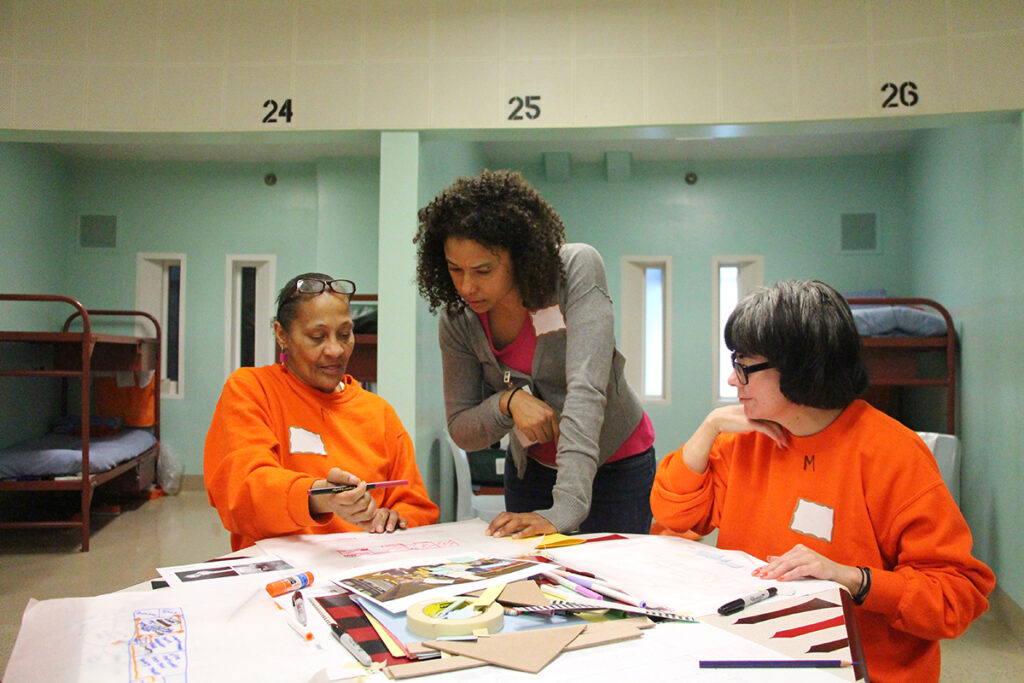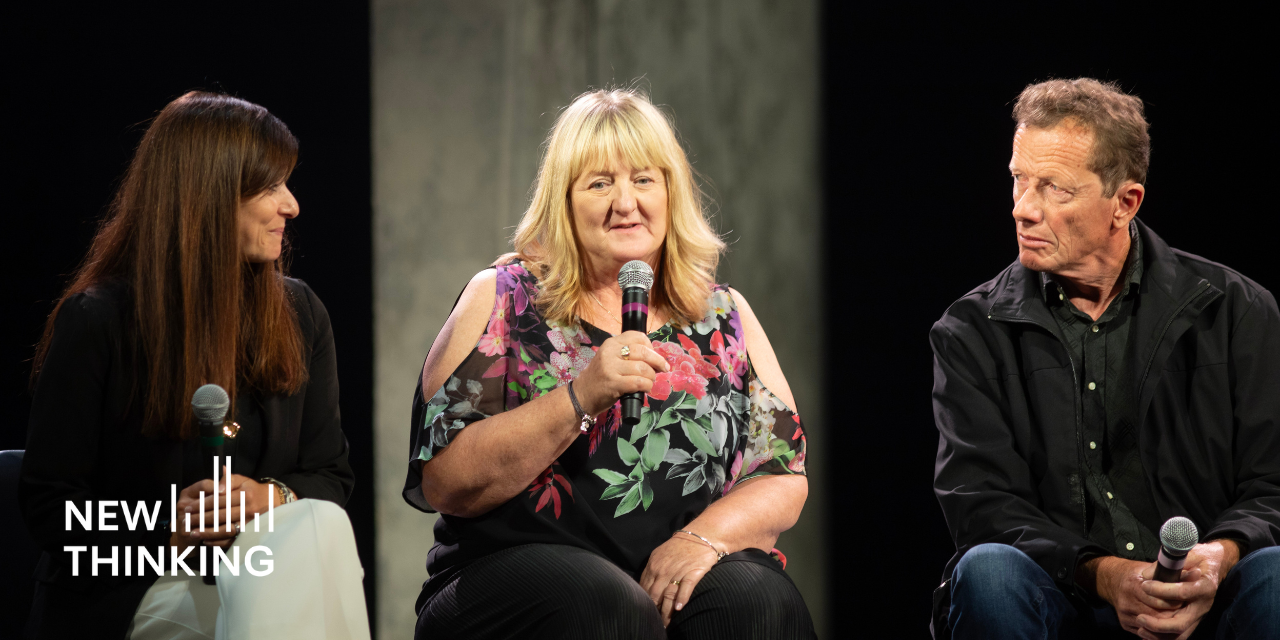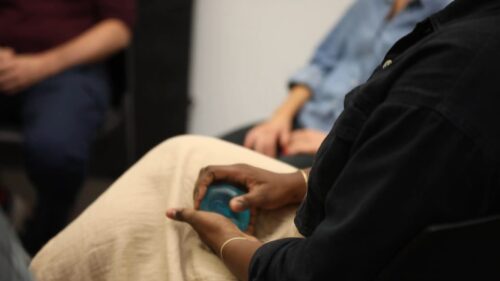
On our New Thinking podcast, the Oakland-based architect Deanna Van Buren explains her firm’s mission to use design to counter incarceration and promote the use of restorative justice. She also discusses her work on our Near Westside Peacemaking Center in Syracuse, N.Y. and her take on the new, more modern jails proposed by the Lippman Commission to replace New York City’s troubled Rikers Island facility. You can read more about her work here, and see a video of her presenting her approach to design and restorative justice.
The following is a transcript of the podcast:
Deanna VAN BUREN:
If you really design for the root causes of incarceration, if you really focus there just like we’ve learned in health, I’m not so sure you’re really going to need them very much.
Matt WATKINS:
Hi, I’m Matt Watkins and you’re listening to The New Thinking Podcast from The Center for Court Innovation. What if we could use the principles of thoughtful human-focused design to roll back this country’s reliance on prisons and jails? That’s the intention of my guest today. Deanna Van Buren is an architect and the co-founder of the Oakland-based Designing Justice, Designing Spaces. Deanna’s mission is to use public interest architecture to counter mass incarceration and to promote the use of restorative justice. Among her many projects, she designed our near west side peacemaking center in Syracuse, New York, the first institution of its kind in the US. Deanna, thanks very much for joining me today.
Deanna VAN BUREN:
Thank you, Matthew.
WATKINS:
So I thought we’d really start out with a big picture question, and it’s a way for me to understand how it is that a design firm sets itself out to end mass incarceration. And I wanted to know what do you see when you look at the design and the physical space of our current justice system, courthouses to prisons, however you want to answer that?
VAN BUREN:
When I used to look at a lot of these spaces, some from the point of view long before I ever started to do this work, they were mostly scary to me. I find them intimidating and as a architecture type, they are representing the values of that system. And in many ways are intended to intimidate and to represent power, and the power dynamics of that system and the hierarchies of that system from the courthouse with its big masonry buildings and judge on the diocese higher up from other folks and the separation of the adversarial parties, very much represents what that system does and what it was made to do.
Prisons and jails obviously intended to promote security and some punishment for actions and it does it all. They all do that very well, and they are ineffective in so many ways and make people really scared and stressed and intimidated, and really worse for the experience of being in them. So it made little sense to replicate that or begin to rethink architecture within the context of the criminal justice system that we know.
WATKINS:
So if we’re not replicating that, then what do you see? What are you proposing as a counter-model to this monumentality that you think is more striking fear than respect it sounds like?
VAN BUREN:
It was always a little hard to initially rethink what justice might look like if it didn’t look like that. And then it was also hard to think about how to work within the system, because the system as we’ve come to learn through movies like 13th and The New Jim Crow, is pretty structurally racist. So as you start to navigate it, you’re really working within a system that’s built on the foundation of slavery and built on the foundations of Jim Crow and then built on the foundations of the war against drugs, which is very much about race. So it was very hard to participate for me in that system. So I think that the real breakthrough was to understand that there were other systems and old system and really it was this idea about a restorative justice philosophy, a restorative justice practice that opened the door for me as an architect and designer to be like, “Oh, well, this system is something that I could design for. This is a system that has gone unnoticed for a long time and is becoming reignited and how could I as an architect, a designer amplify the impact and expansion of this other systems, this old system.”
WATKINS:
And do you want to explain a little bit for people who might not be as familiar with the concept, what restorative justice means for you and how it can provide a solution to some of these problems that are so entrenched to what you’re talking about, The New Jim Crow, for example, these kinds of things?
VAN BUREN:
Sure. Restorative justice in its primary definition is what it really means to me, is that it’s a philosophy that says when a harm has been done, it is essentially a breach of relationship, is not a crime against the state and the people who have been harmed and meeting their needs is the top priority and that those who have committed the offense have an obligation to make amends. They are accountable for those actions and that there is a way, a practice where those parties can come together along with anyone else who’s been impacted by the harm and have a real open dialogue that support any facilitated so that together they can create a plan for those who did the harm to make amends, something that they both agree on with the hope that that individual can repair their relationship and repair the community, repair the individuals that were harmed so they can stay in their community and be unstigmatized if possible.
So that’s a very radical departure from the foundations of the punitive models. So for me, that feels sustainable and it feels more based in human nature and much more natural and organic, because I don’t think justice can be blind and certainly there’s no objectivity in harm that we do to one another. It’s very personal and it’s very rich and diverse and varied in its reasons and its causes.
WATKINS:
So how do we take these principles of restorative justice and start incorporating them into blueprints and concretely literally into design choices?
VAN BUREN:
What’s great about the project that I did with The Center for Court Innovation was that it allowed us the time and space to investigate what that does really look like. We were able to work with you all in community and then your west side and run peacemaking circles that I use to get design input. So I got trained as a circle keeper, and I ran circles around a set of images and ideas, around spaces that may made us feel comfortable.
Syracuse like a lot of our post-industrial cities is in severe decline because there’s no jobs there. So it’s very economically depressed. In the near west side you see a lot of homes that are boarded up or there’s not a lot of commercial activity there, and yet it’s a very culturally rich community, very diverse people from all over the world, a large immigrant population there.
I know that there’s extreme poverty in the community, which has been really a struggle. And then the associative, sometimes violence that goes along with that especially when you have a lot of people coming together in a small space or small community with little resources. So it was a great neighborhood to introduce peacemaking into. And oddly enough, it wasn’t far from downtown in all of the courts. So yes, it feels far, it feels like it’s not close. So the folks we were running circles with were from a range of ages and ethnicities, different kinds of jobs and brought their families. So it was very rich.
WATKINS:
So these are… When you say circles we mean peacemaking circles, a form of restorative justice, correct?
VAN BUREN:
Correct.
WATKINS:
And so what was the goal of the project as a whole, the peacemaking center?
VAN BUREN:
The Center For Court Innovation had come in to bring native American peacemaking practices into a non-native community for the first time, both in Red Hook, Brooklyn and then of course here in Syracuse, then your west side of Syracuse. So they’re training elders in the community to be peacemakers, meeting with the DA and the prosecutors to train them on how to divert cases, quality of life crimes, I believe in particular out of court and into these native American peacemaking processes. So while they were doing a lot of training when I started, and I was able to incorporate my design process into that. So while they’re doing trainings, I’m running circles with the community around what a space for peacemaking should look like, where should it be in the community because it’s location matters. What are the aesthetics of it? What kinds of spaces should be in there, because it’s not a building type that we have and we learned a lot.
WATKINS:
Could you talk a little bit about what you learned and how that informed some of the design choices?
VAN BUREN:
The first piece we learned is that the location of peacemaking needs to be in a neutral territory. We can’t put it somewhere where one part of the community feels ownership, or if there’s a conflict or something happens with someone from another part of the community, they’re not going to feel safe or comfortable going there. Everybody has to feel like it’s a place that they can go, and that’s very real in communities all over the country. We’ve seen that issue over and over again. So neutrality is critical. I want to get a site that feels like it’s a place everyone feels comfortable with. Some of the things that are ideal and what the near west side peacemaking project has is outdoor space. So, that there’s always a connection back to nature. We’ve done a lot of research and evidence-based design in healthcare and educational settings.
And we know that having views to nature, of course being in nature, but just seeing nature can reduce your heart rate in less than five minutes. So it calms you down. So as you’re going into a stressful process for most like peacebuilding, peacemaking, you really need to have as many natural elements in and around the peacemaking center as possible. You also, with an outdoor space can have a place to have circles outside, unlike a court process, you can have peacemaking anywhere, really. It can be outside in a garden or under a tree and as long as there’s privacy, which is another thing we found we needed, you can do that. The peacemaking space is not something that people felt that you should just be able to stumble into. It should be supported and surrounded by other spaces, particularly a chill-out rooms.
We discovered the concept of the cool-off room or the chill-out room, if you need to leave the circle, having a place to go for a little bit. So you can return in a calmer state if necessary, it’s important that people don’t feel trapped and they have a sense of where they’re going. So the idea that you would have walls that might be translucent rather than opaque, but also allow so light can penetrate but you can’t see through it. So it gives privacy but a sense of permeability. We learned to have a kitchen that is a core base in any peacemaking center, as it’s part of the process and it also makes people feel like they’re at home, which was another aspect of peacemaking, this quality that you’re walking into a space that feels familiar to you.
WATKINS:
It’s striking to me listening to you how much everything you’re describing is precisely the opposite of a typical courtroom, or certainly carceral environment.
VAN BUREN:
Yeah. Very true. So they’re not much lessons to be learned in our criminal justice architecture. And so this it’s a starting from scratch. And I think that… What’s amazing is people knew they needed, it wasn’t like we described the ideas and you’re meeting someone who you’ve harmed or someone who’s harmed you. What kind of environment do you need to do that? And these were the things that came out of it. And we did a lot of site observations and we talked to other communities and other similar processes, and just kept getting the same information over and over again.
WATKINS:
And also I think do a lot of work inside of prisons, workshopping these ideas about restorative justice and the design choices that go with it, and I’m wondering what you learned from that process.
VAN BUREN:
Yeah. We’ve done that a lot and it’s been amazing. I have learned so, so much from working with them, often we’ll work with them around a specific project for them that they’ll get on the outside. And I think what has been challenging initially and people think that we’re working with them to make a better prison and that’s always a hurdle with our work, is really trying to explain to them and to others, we are not designing better-looking prisons or prettier boxes to incarcerate people. The folks who are incarcerated, 95% of them are coming home and all of them know what supported in them ending up there in the first place. So they are really smart about what kinds of architecture they need to successfully re-enter. What kinds of environments they would have needed to not ever come in the first place. And they designed some really brilliant things. Things I had never thought of, and many of them are very, very familiar with restorative justice and really deeply understand it and are able to create images of places that are really facilitate restorative justice.
WATKINS:
And I’m wondering as well, if you’re following all the debate about Rikers Island here in New York City, and this proposal to replace Rikers with a series of so-called 21st century, much smaller borough-based jails. I’m wondering, I know you are not in the business of designing or trying to improve upon jail design yourself, but if you had thoughts about what’s happening here with Rikers.
VAN BUREN:
There was something really interesting when I read the Lippman report. The Lippman report was the report that came out about we’re close workers, here’s what we should do. In the first half of that report, I noted I think three to four new building types that they identified that would need to be created to really reduce the population of Rikers. And then the second half of the report elaborates on… and really goes into the different kinds of jail they were going to need. And I thought to myself, if you’ve identified three or four new building types in the first half just briefly, why don’t we focus on those and build those? Because if you did, maybe you really wouldn’t even need those jails at all. And so again, I see this constant focus on redoing the jail when… even in people’s own language and thinking about how to reduce the population, there’s this whole other infrastructure.
I believe drop-off centers was one of them, where if you identify someone who is mentally ill, or has the mental illnesses, which is often the case with a lot of folks and a lot of reasons and people end up incarcerated, this would be a drop-off center where you could bring people because they don’t need to be incarcerated. They actually just need some help. So what did those look like? I would love to design one of those. I would love for us to be focusing on designing those rather than this other focus. So I feel this is an error and where we get lost.
WATKINS:
Well, I guess, it speaks to how much the jail model obviously is entrenched and how we think about justice.
VAN BUREN:
It’s hard to imagine, if you really designed for the root causes of incarceration, if you really focus there, just like we’ve learned in health. I’m not so sure you’re really going to need them very much. You’re not going to need a whole bunch of little small community jails. You’re going to need this whole other range of building types that would really heal people and be of service to people in the community. And I think there’s a ton of them to make, we get calls every day about stuff that we’re going to need and we do need. I could make a whole list for you. It’s so sad to me that the focus is always on this better jail, better prison, because there’s so many, many more things we need to be making.
WATKINS:
Well, Deanna, I’ve really enjoyed learning about your work and your philosophy very much. And I want to thank you so much for joining me today.
VAN BUREN:
Thanks Matthew. I appreciate it.
WATKINS:
I’ve been speaking with Deanna Van Buren. She is the co-founder of the Oakland-based architecture and development practice, Designing Justice, Designing Spaces. You can find out more about her work by looking at the show notes for this episode. Our theme music is by Michael Aaron at quivernyc.com. I’m Matt Watkins, and this has been The New Thinking Podcast from The Center For Court Innovation. Please consider giving us a review in Apple Podcasts. It helps new people discover the show. Thanks for listening.


